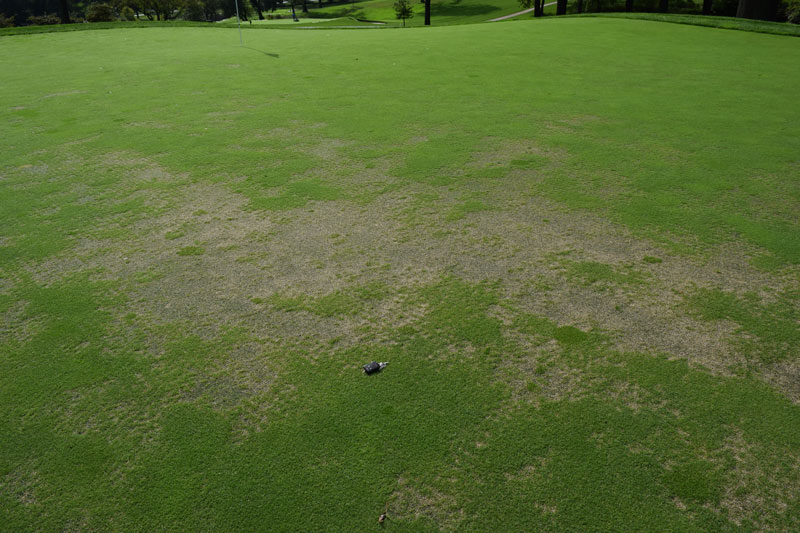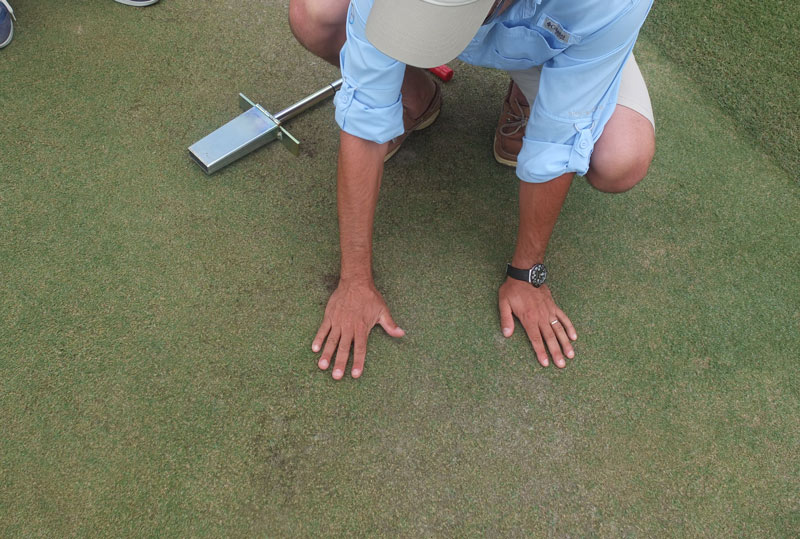
Symptoms of nematode damage in cool-season turf are often uncharacteristic, so they’re usually confused with a variety of other potential problems. Photo by Zac Reicher/Bayer
Nematodes in cool-season turf
The past year has provided tremendous insight into nematodes in the cool-season region. Though we’ve known since the 1960s that nematodes were infecting cool-season turf, the release of Indemnify early last year has increased awareness of nematode issues and given us the opportunity to learn more about these potentially damaging pests in the northern half of the U.S.
Nematode issues are widespread. Nematode damage has been documented from the East Coast to the West Coast, and from the northern to southern borders of the U.S.
Every course/green is different. On most golf courses, only some greens or portions of some greens have high enough populations to cause visible symptoms or decreased performance. Nematode populations among neighboring courses are rarely correlated.
Symptoms may not be clearly visible. Turf performance that is slightly lower than expected or “just doesn’t fit” is typical under limited stress. However, if stress is increased, symptoms can be amplified quickly.
Nematodes are often confirmed after all other problems have been ruled out. Nematode symptoms often appear as different biotypes of annual bluegrass or segregating creeping bentgrass. Symptoms are commonly misdiagnosed as Pythium root rot, summer patch, localized dry spot, fairy ring or other soil-based problems.
Symptoms are largely impacted by other stresses. Heat, slight drought, aerification and topdressing are all stresses that can be enough to enhance symptoms in greens infected with nematodes.
If using Indemnify to control nematodes:
- Improvement may be seen in days or weeks, and speed of improvement is directly related to environmental conditions and growth rate.
- Effective control is often seen as an improvement in turf quality, reduced need for hand watering, and/or improved response to fertility or irrigation. A reduction in nematode populations cannot always be documented, likely because of the variability in sampling.
- We have observed the greatest response with the high rate of Indemnify and usually at least two applications for most effective control of root-infecting nematodes.
Do your due diligence before deciding whether to attempt control. Control decisions are highly specific to each course depending on expectations, budget, degree of damage, species and size of populations, etc. Contact as many sources as possible to help with this decision.
See Best management practices for nematode control with Indemnify in the Northern U.S. for more information, and contact your Bayer area sales manager if you need assistance.
— Zac Reicher, Ph.D., and Rob Golembiewski, Ph.D.
Nematodes in warm-season turf

Lack of air movement, poor drainage, verticutting and aerification can all enhance nematode symptoms in warm-season turf. Photo by Derek Settle/Bayer
2017 was the first full year of Indemnify use for turfgrass nematodes in the United States. Newer nematicides like Indemnify have dramatically reduced the damaging effects of sting and root-knot nematodes on golf greens from the transition zone to South Florida and the Texas Gulf Coast.
Sting nematodes are most damaging. Sting nematodes are the most pathogenic root-feeding nematodes in bermudagrass or bentgrass greens in the southern U.S. They can be difficult to control because they feed on root tips and are typically found deeper in the root zone (8 inches or more).
Root-knot nematodes are everywhere. Multiple species of root-knot nematodes exist and spend much of their life cycle inside the root. Lab analysis can thus be inaccurate, and the endoparasitic feeding behavior makes control difficult.
Effective curative control. Curative control with Indemnify is well documented, with the high rate (0.39 fl. oz./1,000 square feet) providing positive visual effects in as few as two to seven days after application. Additionally, Indemnify provides effective preventive control when applied prior to symptoms of nematode feeding.
Every course/green is different. On most golf courses, only some greens or portions of some greens have high enough populations to cause visible symptoms or decreased performance.
The straw that breaks the camel’s back. Greens with visible nematode symptoms tend to be the same ones each year. This is usually because they have other agronomic or environmental issues that enhance the root-feeding stress by nematodes. Lack of air movement, poor drainage, fungal root rot, cool or hot conditions, verticutting, aerification, and topdressing are all stresses that can be enough to enhance symptoms in warm-season turf.
Symptoms may not be clearly visible. Turf performance that is slightly lower than expected or “just doesn’t fit” is typical under limited stress. However, if stress is increased, symptoms can be amplified quickly. For example, the thinning of a green’s surface in cleanup laps or on collars is often related to nematode populations in bermudagrass.
Nematodes are often confirmed after all other problems have been ruled out. Nematode symptoms are commonly first misdiagnosed as stress diseases or other abiotic problems such as take-all root rot, Pythium root rot, leaf and sheath spot (Rhizoctonia zeae), nutrient deficiency, localized dry spot, or other soil-based problems.
If using Indemnify to control nematodes:
- Improvement may be seen in days or weeks, and speed of improvement is directly related to environmental conditions and growth rate.
- Effective control is often seen as an improvement in turf quality, reduced need for hand watering, and/or improved response to fertility or irrigation. A reduction in nematode populations cannot always be documented, likely because of the variability in sampling.
- Most effective control of root-infecting nematodes is usually seen with two applications at the high rate (0.39 oz./1,000 square feet) timed 14 to 28 days apart.
Do your due diligence before deciding whether to attempt control. Control decisions are highly specific to each course depending on expectations, budget, degree of damage, species and size of populations, etc. Contact as many sources as possible to help with this decision.
See Best management practices for nematode control with Indemnify in the Southern U.S. for more information, and contact your Bayer area sales manager if you need assistance.
— Derek Settle, Ph.D.